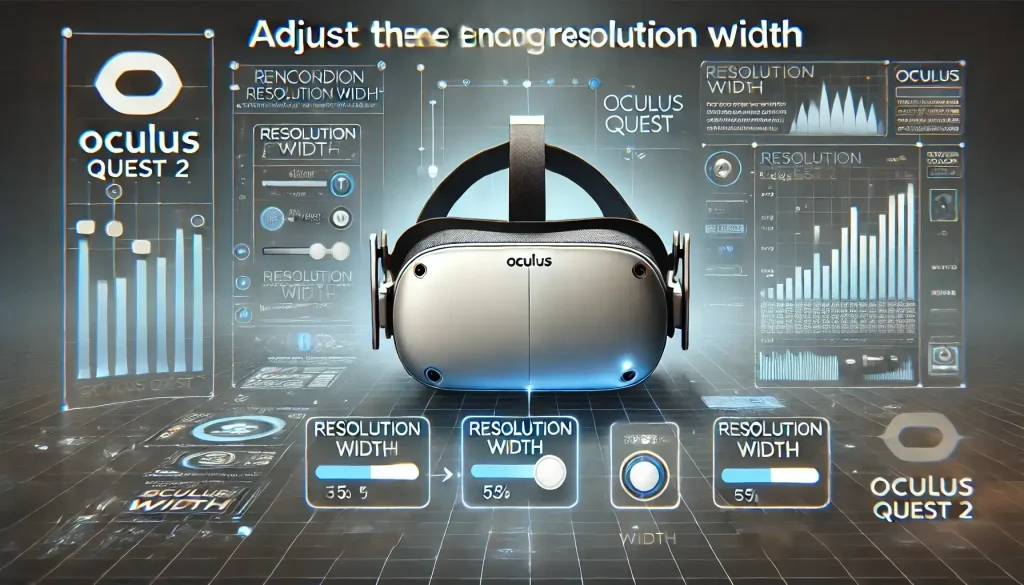Ever noticed that your Oculus Quest 2 visuals could feel just a bit sharper or smoother? Or found yourself juggling between silky performance and crisp quality? Well, the secret sauce to striking that perfect balance is a little-known setting called “Encode Resolution Width.”
It sounds technical, we know, but don’t worry—we’ve got you covered. By the end of this guide, you’ll know exactly what encode resolution width is, why it matters, and how to tweak it to suit your VR setup. Whether you want sharper visuals or flawlessly smooth gameplay, this setting can make a world of difference.
What Is Encode Resolution Width in Oculus Quest 2?
Encode Resolution Width is basically the horizontal resolution of the video stream sent from your PC to your Quest 2 headset. It comes into play when you’re using Oculus Link or Air Link to play PCVR games.
Here’s why it’s important:
- Higher Resolution Width = Sharper visuals, more immersive gaming experience.
- Lower Resolution Width = Better performance, less strain on your GPU and network.
Finding the right balance is key—too high, and you might face lag or stuttering; too low, and the visuals look like you’re playing on a potato. Nobody wants that.
Suggested: How to Fix High Ping in Roblox?
How to Adjust Encode Resolution Width on Your Oculus Quest 2
If you’re ready to tinker with your settings, grab your headset and let’s jump in! Here’s how you can tweak the encode resolution width in a few simple steps:
1. Open the Oculus Debug Tool (ODT)
To access the setting, you’ll need to use the Oculus Debug Tool (ODT). Don’t worry, this sounds fancier than it actually is. Here’s where to find it:
- Go to this folder on your PC:
`C:\Program Files\Oculus\Support\oculus-diagnostics`
- Double-click on `OculusDebugTool.exe` to launch it.
2. Adjust the Encode Resolution Width
Once the Debug Tool is open, you’ll see a bunch of techy-looking options. Don’t get overwhelmed! Just focus on the “Encode Resolution Width” field. By default, it’s set to 2912, which is a good middle-ground. But here’s how you can tweak it based on your hardware:
- For sharper visuals (e.g., high-end GPUs like RTX 3080/3090): Set it to 3648.
- For balanced performance (mid-range GPUs like GTX 1660 or RTX 2060): Keep it at 2912.
- For smoother gameplay on older setups (low-end GPUs like GTX 1050): Drop it to 1920.
Adjust the value, close the Debug Tool, restart the Oculus software, and you’re good to go.
3. Apply and Test
After restarting, fire up your favorite PCVR game and see how it looks. If things are a bit laggy, you might need to lower the setting. If it feels buttery smooth but lacks that crisp detail, bump it up a notch. Trial and error is your best friend here.
Don’t Miss: Best iMessage Games for Couples
Optimizing Encode Resolution Width for Performance
Not every VR setup is created equal, so here are some tips to help optimize your encode resolution width for both performance and quality.
Match Resolution to Your GPU
Your GPU determines how much visual juice you can squeeze out of your headset. Here’s a quick guide:
- High-end GPUs (e.g., RTX 3070/3080/3090): Go bold with 3648 for eye-popping visuals.
- Mid-range GPUs (e.g., GTX 1660/Ti or RTX 2060): Stick with 2912 for a great balance of clarity and performance.
- Low-end GPUs (e.g., GTX 1050/Ti or GTX 1650): Dial it down to 1920 to avoid stuttering.
Network Tips for Air Link
Using Air Link? Then your network plays a huge role in performance. Here’s how to keep everything smooth:
- Use a reliable 5GHz Wi-Fi connection (no, your old 2.4GHz network won’t cut it).
- Minimize interference by placing your router close to your play area.
- Avoid crowded networks—your roommate streaming 4K Netflix may upset your VR flow.
Experiment & Use Performance HUD
Every setup is unique, so don’t be afraid to experiment. Use the Oculus Performance HUD to monitor things like frame rates and latency as you adjust settings. Incremental tweaks will help you find that VR sweet spot.
Troubleshooting Common Issues
Sometimes, adjusting the encode resolution width might result in hiccups. Don’t stress! Here are some quick fixes for common problems:
Blurry Visuals After Adjustments
- Double-check that the new setting is applied by restarting the Oculus software.
- Update your GPU drivers—they might hold the key to better compatibility.
Lag or Stuttering
- Reduce the resolution width to ease the burden on your GPU or network.
- Lower in-game graphics settings if needed.
Changes Not Saving
- Run the Debug Tool as an administrator.
- Ensure your Oculus software is up to date.
Extra Tips for the Best VR Experience
Looking to push your VR experience even further? These simple tips can supercharge your gaming sessions:
1. Keep Firmware Updated: Oculus regularly rolls out updates that can improve performance and compatibility.
2. Invest in Quality Cables (for Link users): The official Link cable is great, but there are third-party options that rival its quality. Just don’t settle for cheap, no-name cables.
3. Test Across Games: Different games demand different resources. A resolution width that works beautifully for one game might need tweaking for another.
Sharpen or Smooth? It’s All Up to You!
Tinkering with encode resolution width on your Oculus Quest 2 is one of the easiest ways to level up your VR experience. Whether you’re chasing razor-sharp details to fully immerse yourself or prioritizing buttery-smooth gameplay, it’s a setting that offers plenty of flexibility.
Take some time to experiment with different values, monitor your performance, and find what works best for your setup. Tech should adapt to you, not the other way around.
Happy gaming, and may your VR adventures be crystal clear (or deliciously lag-free)!


